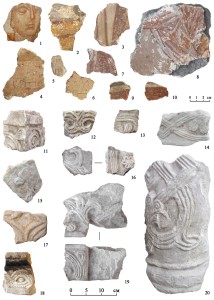 Leonid А. Belyaev*, Irina А. Safarova**, Aleksandr N. Khokhlov***
Leonid А. Belyaev*, Irina А. Safarova**, Aleksandr N. Khokhlov***
The Institute of Archaeology of the RAS, Moscow, Russia
*E-mail: labeliaev@br.ru
**E-mail: irina@safarov-tver.ru
***E-mail: anhbalt@mail.ru
Keywords: architectural archeology, funeral ceremony, the architecture of 13th‑14th centuries, frescoes, decorative carvings, Tver principality.
In 2012–2014, the expedition of the Institute of Archeology of the RAS uncovered the remains of the Transfiguration Cathedral in Tver. It was the first stone church erected ex nihilo (1285–1290) in Vladimir-Suzdal Rus after the Mongol invasion of 1237–1238. In 1689–1696 it was replaced with a new cathedral, which was destroyed in 1935. Thus, the foundations of the 13th century cathedral were destroyed twice. However, the ditches and remains of stonework allowed distinguishing the ancient cathedral from the church of the 17th century and restoring their plans. Besides, there was a cemetery found, which was established at the earlier wooden cathedral of Sts Kosma and Damian (12th–early 13th century). The temple was built of limestone. It had four internal piers, two aisles and three apses. The size of the dome square (4.5–4.7 m) classifies the cathedral church among middle or even large churches of the 12th‑13th centuries. The collected decoration fragments are few, but the features of the facade stone carving allow us to reliably attribute it to the Vladimir-Suzdalian tradition, and small fragments of the frescoes indicate the painting of the interior. Thanks to the excavations, one of the key issues of the history of the ancient Russian architecture can be considered as solved.
DOI: 10.7868/S0869606318020113







